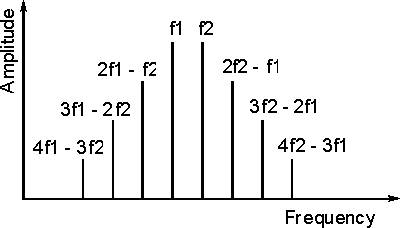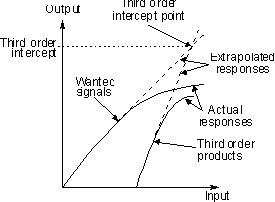Intermodulation distortion, cross modulation and intercept point
- an overview or tutorial of the basics of radio receiver dynamic range
performance, including sensitivity, and overload performance as well as
intermodulation distortion, intercept point and blocking and their effect on
radio communications systems.
There are many parameters that are of great importance for
radio receivers whether they are used for broadcast reception or for more
exacting radio communications applications such as two way radio communications,
or fixed or mobile radio communications. Of the radio receiver parameters,
sensitivity is important but equally so is the way in which a receiver handles
strong signals. Specifications including intermodulation distortion, third order
intercept point, cross modulation and blocking can be equally vital. In any
receiver design a good balance must be achieved between the sensitivity and the
strong signal handling capability. Under some conditions receivers may need to
contend with signals that are only a few microvolts, but equally they need to
handle the conditions when many millivolts enter the front end of the radio
receiver.
RF amplifier
Under normal conditions the RF amplifier of a radio receiver
should remain linear with the output remaining proportional to the input.
Unfortunately even the best RF amplifiers have limits to their output
capability, and beyond this they start to overload. When this happens their
output starts to limit and the output is less than expected. At this point the
amplifier is said to be in compression.

The characteristic curve for an amplifier
Compression in itself is not a problem. The absolute values
of a signal are of little value and in any case the automatic gain control (AGC)
used in most radio receivers means that the gain is reduced when strong signals
are being received. However the side effects of compression give rise to major
problems. Effects like intermodulation distortion, cross modulation, blocking
and others mean that the operation of the radio receiver can be seriously
impaired. It is these aspects which are of great importance in the radio
receiver design.
To help prevent these problems occurring, radio receivers
have a number of methods of reducing the signals levels. The most important is
the AGC. This is standard on virtually every receiver and operates on many of
the amplifier stages within the set. It prevents the signals from becoming too
large, especially in the later stages of the set. However it cannot always
prevent the front end stages from being overloaded. This is particularly true
when the offending strong signal is slightly off channel. In this case it will
enter the early stages of the set but not pass through the IF filters (assuming
the receiver is a superhet or superheterodyne radio receiver). This will mean
that the AGC will not be affected but the signal is still able to overload some
of the early stages.
Some HF communications receivers used for professional radio
communications applications have an attenuator on the input, although many
receivers used in units for two way radio communications links of fixed or
mobile radio communications such as cellular telecommunications, PMR and the
like will not have these and the receiver will need to be able to handle the
strong signals without this assistance.
In view of the importance of the various aspects of
overloading, a number of specifications quantify the various problems caused.
However to look at these it is necessary to look at the effects and how they
arise.
Distortion
The problems from compression arise as a result of the
distortion which occurs to the signal when the amplifier runs into compression.
The actual method which gives rise to problems may not be obvious at first
sight. It can be viewed as the combination of two effects. However to see how it
arises it is necessary to look at some of the basic effects of compression.
One of the forms of distortion which arises is harmonic
distortion where harmonics of the wanted signal are produced. Depending upon the
exact way in which the signal is compressed the levels of even order harmonics
(2f, 4f, 6f, etc) and odd order harmonics (3f, 5f, 7f, etc) will vary. As a
result of the production of these harmonics it is possible that signals below
that being received could be picked up. However the RF selectivity is likely to
remove these signals before they enter the first stages of the receiver.
Another effect which can be noticed is that the RF amplifier
tends to act as a mixer. The non-linear transfer curve means that signals will
mix together or modulate one another. This effect is known as intermodulation.
It is unlikely that this effect on its own would give any problems. The mix
products from signals close to the wanted one fall well away from the received
signal. Alternatively, to produce a signal within the receiver pass-band,
signals well away from the received one would need to be entering the RF
amplifier. These would normally be rejected by the RF selectivity. Take the
example of two signals on 50.00 and 50.01 MHz. These would mix together to give
signals at 0.01 MHz and 100.01 MHz. These are not likely to give rise to any
problems.
Problems start to arise when the two effects combine with one
another. It is quite possible for a harmonic of one signal to mix with the
fundamental or a harmonic of the other. The third order sum products like 2f1 +
f2 are unlikely to cause a problem, but the difference products like 2f1 - f2
can give significant problems. Take the example of a receiver set to 50 MHz
where two strong signals are present, one at 50.00 MHz and the other at 50.01
MHz. The difference signals produced will be at 2 x 50.00 - 50.01 = 49.99 MHz
and another at 2 x 50.01 - 50 = 50.01 MHz. As it can be seen either of these
could cause interference on the band. Other higher order products can also cause
problems: 3f1 - 2f2, 4f1 - 3f2, 5f1 - 4f2, and so forth all give products which
may could pass through the receiver if it is tuned to the relevant frequency.

Intermodulation products from two signals
In this way the presence of a strong signal can produce other
spurious signals which can appear in its vicinity. The signals mixing with one
another in this way may be of a variety of different types, e.g. AM, FM, digital
modulation, etc, all of which may combine together to give what is effectively
noise. This means that poor third order intermodulation performance can have the
effect of raising the noise floor under real operating conditions. In turn this
can appear to reduce the sensitivity of the radio receiver which in turn can
degrade the performance of the overall radio communications system.
Third order intercept point
It is found that the level of intermodulation products rise
very fast. For a 1 dB increase in wanted signal levels, third order products
will rise by 3 dB, and fifth order ones by 5 dB. This can be plotted to give a
graph of the performance of the amplifier. Eventually the RF amplifier will run
into saturation and the levels of all the signals will be limited. However if
the curve of the wanted signals and the third order products was continued, the
two lines would intersect. This is known as the third order intercept point.
Naturally the higher the level of the intercept point, the better the
performance of the amplifier. For a good radio receiver and intercept point of
25 dBm (i.e. 25 dB above 1 milliwatt or about 0.5 watt) might be expected.

The third order intercept point of an amplifier
Blocking
When a very strong off channel signal appears at the input to
a receiver it is often found that the sensitivity is reduced. The effect arises
because the front end amplifiers run into compression as a result of the off
channel signal. This often arises when a receiver and transmitter are run from
the same site and the transmitter signal is exceedingly strong. When this occurs
it has the effect of suppressing all the other signals trying to pass through
the amplifier, giving the effect of a reduction in gain.
Blocking is generally specified as the level of the unwanted
signal at a given offset (normally 20 kHz) which will give a 3 dB reduction in
gain. A good receiver may be able to withstand signals of about ten milliwatts
before this happens.
The blocking specification is now more important than it was
many years ago. With the increase in radio communications systems in use, it is
quite likely that a radio transmitter will be operating in the close vicinity to
a receiver. If the radio receiver is blocked by the neighbouring transmitter
then it can seriously degrade the performance of the overall radio
communications system.
Cross modulation
Another effect which has an effect on the radio receiver
dynamic range is known as cross modulation. This is noticed in the presence of
strong signals on adjacent channels. When this occurs the modulation from a
strong signal can be transferred onto other signals being picked up. This effect
is particularly obvious when amplitude modulated signals are being received. In
this case the modulation of another signal can be clearly heard.
Cross modulation normally arises out of imperfect mixer
performance in the radio, although it can easily occur in one of the RF
amplifiers. As it is a third order effect, a receiver with a good third order
intercept point should also exhibit good cross modulation performance.
To specify the cross modulation performance the effect of a
strong AM carrier on a smaller wanted signal is noted. Generally the level of a
strong carrier with 30% modulation needed to produce an output 20 dB below that
produced by the wanted signal. The wanted signal level also has to be specified
and 1mV or -47dBm (i.e. a signal 47 dB below 1 mW) is often taken as standard,
together with an offset frequency of 20 kHz.
Summary
When a radio receiver is designed for use in a radio
communications system or even if it is used for broadcast reception, then it is
important to ensure that not only does it have the required sensitivity, but
that it can perform well under conditions when strong signals are present. With
radio communications equipment becoming more widespread, this the dynamic range
of the radio receiver and its strong signal handling at key elements of its
performance. If the receiver fails to operate correctly under these conditions
then the performance of the whole radio communications system may be
compromised.
|

